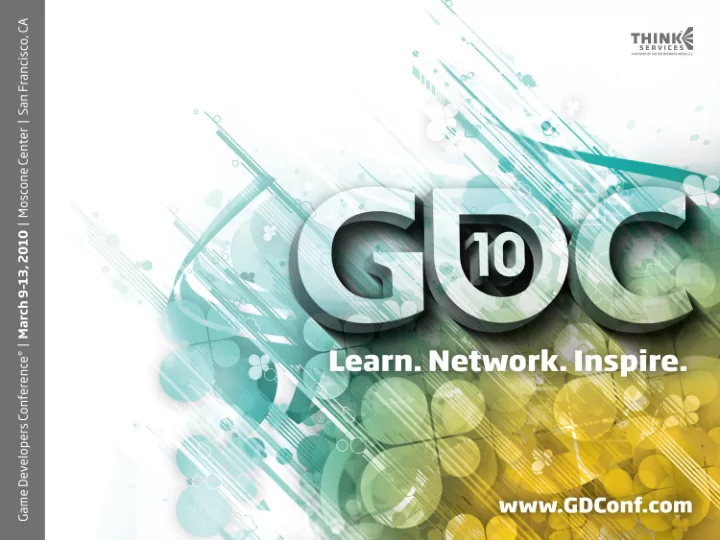

APB: Creating a Powerful Customisation System for a Persistent Online Action Game Maurizio Sciglio Simon Taylor
Outline Goals Initial Design Refinements Demo Scalability Conclusions
GOALS
What is APB? “Persistent Online Action Game” Shared player-space Fast-paced 3 rd -person gameplay RTW-run backend Customisation a key selling point PC initially Unreal Engine 3
Decal Application – Forza
Decal Application – Forza
Decal Application Not just vehicles; characters too Characters are harder: More complex shape/UV mapping Heterogeneous surface (clothing, hair, etc.) Complex masking for clothing Therefore, simple UV-space composition not possible
Other Requirements Face & body customisation Hair styles Clothing application with large variety of available styles Decal application Tattoos on skin Print on clothes
MMO Concerns Large player count Limited bandwidth No upfront “Lobby” Players enter and leave at any time
INITIAL DESIGN
Parametric Description Final assets (meshes & textures) are big E.g. 1 MB for a 1024x1024 DXT5 texture Bandwidth is expensive Can’t send final assets over the network Therefore, describe assets parametrically Build final assets on clients Fundamental principle of the system
Morphing Fundamental mesh operation Standard additive morphing Used for Body & Facial modification Sliders control individual target weights
Decals / Tattoos
Skin Tone
Skin Pigment
Skin – Additional Features
Clothing Customisation Rendering / memory cost independent from the number of items One mesh to rule them all! Clothing mesh must be merged with the base mesh Texture must be combined with the base texture
Clothing – Morph Item
Clothing – Extra Mesh Item
Mesh Culling
UV Layout
UV Layout
Character Materials Main goals: Single draw call per character Support multiple materials BRDF decompositions stored in a 3D texture N dot L R dot V Per-pixel material selection Phong decomposition
REFINEMENTS
Decal Projection Issues Slow to construct Large data size Layer count had to be restricted Artists didn’t like this In most cases, not actually required Solution: Symbols
Symbols
Distance-Field Encoding Distance-field Regular Texture encoded [http://www.valvesoftware.com/publications/2007/SIGGRAPH2007_AlphaTestedMagnification.pdf]
Height Scaling Customisable character height Per-bone non-uniform scaling Many issues Artist time Animation issues Collision implications Fairness Bugs!
Height Scaling
Projection Seams
Projection Seams
Hair-Clothing Interactions
Original
With Fitting Morphs
Demo
SCALABILITY
Bandwidth …is expensive Even parametric representation is big Bandwidth is n 2 in player count Must minimise data size Quantise parameters zlib compress all data Average ~4 kB per character Limit complexity user can create
Background build Assets built during gameplay Two options Threads Time-slicing Problems with threads No multithreaded D3D access Less control We chose time-slicing
The Correct Choice? Time-slicing brings its own issues Developer time Frame-rate spikes No true parallelism In hindsight, threads were maybe the better option
Memory Management Memory use for customised assets is huge Too slow to build on-demand Therefore, must write out assets to disk cache Textures and meshes streamed from cache files Total memory usage capped Not persistent
RESULTS & CONCLUSIONS
Future Work Blend-weight morphing Physics simulation on hair and clothes Improved hair rendering DXT Compression Better descriptor compression Persistent disk cache
Conclusions Customisation needs time and resources Roughly 50% of graphics team workload Significant proportion of memory and CPU/GPU resources dedicated to it Get art pipeline sorted first Flexibility is key For artists and players Distance fields are fantastic
Questions? maurizio.sciglio@realtimeworlds.com simon.taylor@realtimeworlds.com www.realtimeworlds.com www.apb.com
Recommend
More recommend